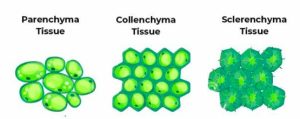Question 1 Write down the functions of Sclerenchyma?
Question 2 Write down the functions of parenchyma?
Question 3 Write down the functions of collenchyma?
Question 4 What is the function of stomata?
Question 5 How is meristematic tissue different from permanent tissue?
Question 6 Explain the structure of stomata?
Question 7 Name two types of permanent tissue?
Question 8 What are cork cells?
Question 9 What are the functions of cork cells?
Contents
Permanent Tissue
Cells derived from division of meristematic take up specific role and loose the ability to divide they thus form permanent tissue. The development process by which cells have been derived from meristematic tissue, take up permanent shape, size and function is called differentiation.
These can be further divided into:
Simple Tissues
(i) Parenchyma
(ii) Collenchyma
(iii) Sclerenchyma
Complex Tissues
(i) Xylem
(ii) Phloem
(1) Simple
These tissues are made up of cell which are structurally and functionally similar.
(i) Parenchyma
They are living, have power of division, rounded or isodiametric (equally expanded on all sides) or oval or polygonal. Cell wall is thin, small nucleus, large central vacuole, loosely packed cells. Present in stems, leaves, flowers, fruits.
Function
(1) They serve as a packing tissue and fill the spaces between other tissue.
(2) Maintain the shape and firmness of plant.
(3) They store and assimilate food. They are food storage tissue.
(4) Transport of material occur through cell wall.
(5) They are metabolically active, their intercellular spaces allow gaseous exchange.
(6) They store waste product of plants.
(7) If chloroplast is present, these tissue are called as chlorenchyma and perform photosynthesis.
(8) In hydrophytes large air cavities are present in parenchyma to give buoyancy to the plants. Such type are called as aerenchyma.
(ii) Collenchyma
Intercellular spaces are generally absent, elongated shape, extra cellulose deposited at corners of cell. They are located below epidermics of dicotyledon stem, petiole of leaf stalk, absent in monocot of stem, roots and leaves.
Functions
(1) They provide mechanical support and elasticity to dicotyledonous stem.
(2) Provide tensile strength and flexibility.
(3) Allow easy bending in various parts of plants without actually breaking it.
(iii) Sclerenchyma
They are dead cells, do not have protoplasm. Walls are greatly thickened with deposition of lignin (chemical substance which act as cement and hardens them). Cells are closed packed without intercellular spaces.
(1) They have mechanical and protective function.(2)They give strength, flexibility and elasticity to plant body.
They are of 2 types:
(1) Epidermis
(2) Cork or phellem
Epidermis
It is the outermost layer of cell. It is made up of one cell thick or single layer of cells. They are covered with cuticle(it is water proof layer of waxy substance). In xerophytic or desert plants, cuticle is thick and protect again water loses. Cells of epidermis are elongated, flattened, do not contain any intercellular spaces between them.
They protect plant from loss of water, mechanical injury and invasion by parasitic fungi.
Cork
Cork cells are dead, compactly arranged, no intercellular spaces, rectangular, vacuolated. As plant grow older, the outer protective tissues undergo certain changes. A strip of secondary meristem called cork cambium replaces epidermis of stem.
The wall of cork cell contain suberin(organic substance). It makes the cell impermeable to water and gases. They are filled with tannins or resins.
Cork cell prevent loss of water from plant body, infection and mechanical injury.



Thanks for the help
what are permanent tissue
Permanent tissues in a plant are those tissues that contain non dividing cells. The cells are also modified to perform specific functions in the plants. The cells of the permanent tissue are derived from the meristematic tissue.